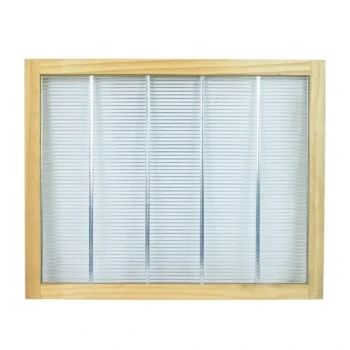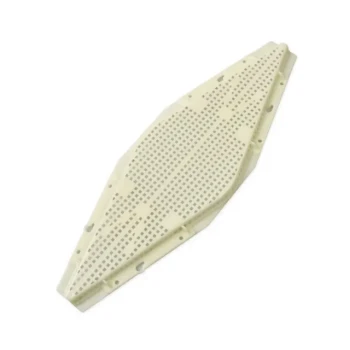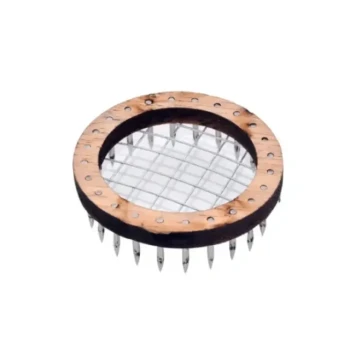The definitive answer is no. Drones, the male bees in a colony, are too large to pass through the gaps in a standard queen excluder. This design is intentional, but it can lead to a significant problem if drones emerge from their cells in a box above the excluder, as they will become trapped.
A queen excluder works by size exclusion. While it successfully contains the larger queen to the brood boxes, it also traps the similarly sized drones, which can lead to them getting stuck and dying while trying to exit the hive.
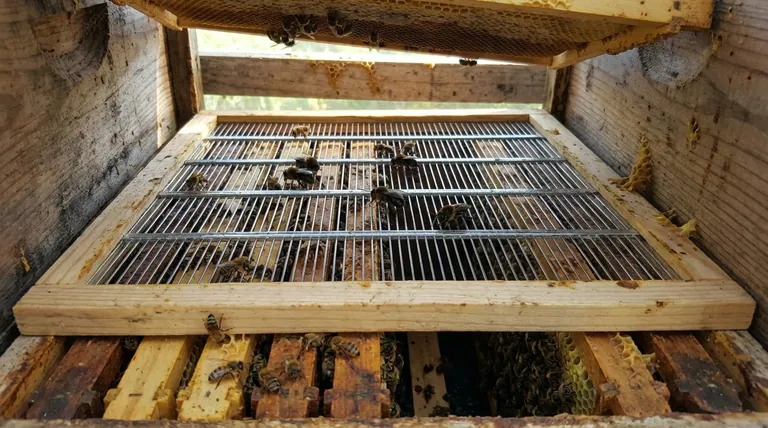
How a Queen Excluder Works
A Barrier Based on Size
A queen excluder is a simple grid, made of either metal or plastic, with precisely sized openings.
These openings are large enough for the smallest bees in the hive—the worker bees—to pass through freely.
However, the gaps are too narrow for the larger body of a queen bee, effectively confining her to the brood chamber and preventing her from laying eggs in the honey supers.
The Goal: Pure Honey Supers
The primary purpose of an excluder is to ensure honey supers remain free of brood (eggs, larvae, and pupae).
This separation makes honey harvesting cleaner and simpler for the beekeeper, as there is no risk of damaging brood frames or mixing brood into the harvested honey.
Why Drones Get Trapped
The Anatomy of a Drone
Drones are the male bees in the colony, and their primary role is to mate with a queen.
They are significantly larger and bulkier than worker bees, with a wider thorax and abdomen. In terms of size, they are much closer to a queen than to a worker.
A Fatal Miscalculation
Because drones are roughly the same size as the queen, the excluder that blocks her also blocks them.
When a drone attempts to force its way through an excluder, it inevitably gets stuck. This not only leads to the drone's death but also clogs the excluder, impeding the movement of worker bees.
Common Pitfalls and Management Errors
Trapped in the Supers
The most common issue arises when drones hatch in a honey super placed above a queen excluder. This can happen if the beekeeper inadvertently moves a frame containing drone brood up from the brood box.
Once these drones emerge as adults, their instinct is to leave the hive for mating flights. They are blocked by the excluder below and the hive cover above, leaving them with no escape.
A Mass Die-Off
As the reference material notes, this scenario results in drones dying in large numbers, often with their bodies stuck halfway through the excluder.
This is not only distressing but also creates a significant cleanup job for the worker bees and can disrupt the flow of traffic and ventilation within the hive.
How to Apply This to Your Hive
Proper management is key to preventing drones from becoming trapped.
- If your primary focus is honey production: Before placing the queen excluder, perform a thorough inspection to ensure all frames with brood, especially drone brood, are located in the brood box below the excluder.
- If you find drones trapped in your supers: You must intervene. The simplest solution is to remove the queen excluder temporarily or provide an upper entrance to the super so they can fly out.
- If you are conducting a routine hive check: Always confirm the queen's location before closing the hive. Accidentally trapping her above the excluder is a critical error, and any drones she lays will subsequently be trapped as well.
Understanding how your equipment impacts the entire colony—not just the queen—is fundamental to successful beekeeping.
Summary Table:
| Situation | Outcome | Prevention/Tip |
|---|---|---|
| Drone emerges in super above excluder | Gets trapped, dies, clogs excluder | Ensure all brood frames are below excluder before placing it |
| Drone attempts to pass through excluder | Body is too large; gets stuck | Understand that excluders block both queens and drones by design |
| Multiple drones trapped | Mass die-off, disrupts hive traffic | Provide an upper entrance or temporarily remove excluder to release them |
Equip your apiary for success with HONESTBEE.
As a trusted wholesale supplier for commercial apiaries and beekeeping equipment distributors, we understand that proper equipment is the foundation of a productive and healthy operation. Trapped drones are a sign of a management issue that the right tools and knowledge can prevent.
Let HONESTBEE be your partner in efficiency. Our durable, precision-made queen excluders and other essential supplies are designed to support the complex needs of your hives, helping you maximize honey production and maintain strong colonies.
Ready to optimize your beekeeping operation? Contact our wholesale team today to discuss your equipment needs and volume pricing.
Visual Guide
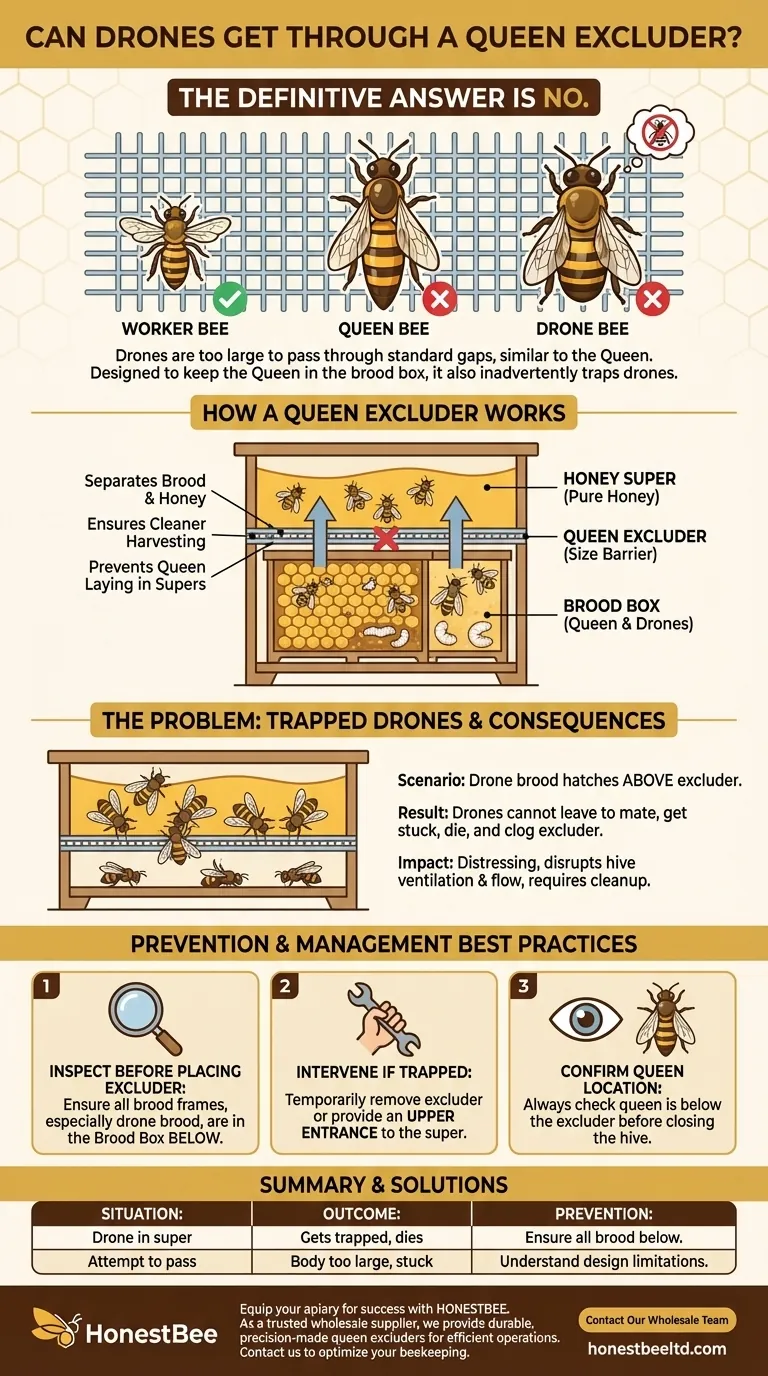
Related Products
- Premium Wood Framed Metal Wire Queen Bee Excluder
- Professional Plastic Queen Excluder for Modern Beekeeping
- Plastic Queen Bee Excluder for Bee Hive Wholesale
- Wooden Queen Bee Excluder for Beekeeping
- High Performance Plastic Queen Excluder for Beekeeping and Apiary Management
People Also Ask
- Do I really need a queen excluder? A Guide to Maximizing Your Honey Harvest Efficiency
- What considerations should a beekeeper take into account when deciding whether to use an excluder?
- Can a queen get through a queen excluder? A Guide to Preventing Hive Failures
- Where should a queen excluder be placed in a beehive? The Key to Hive Organization
- What are the advantages of using a queen excluder? Maximize Honey Yield & Hive Control
